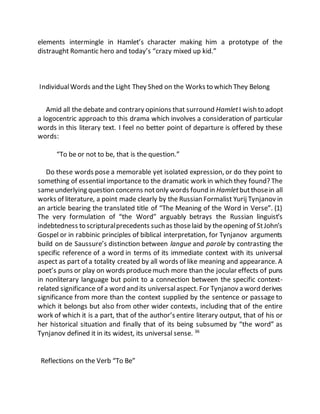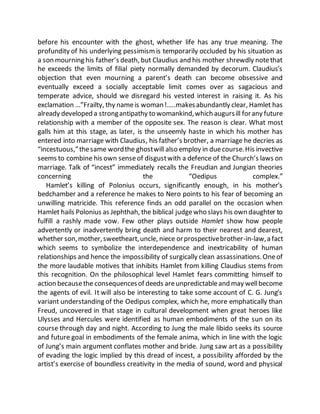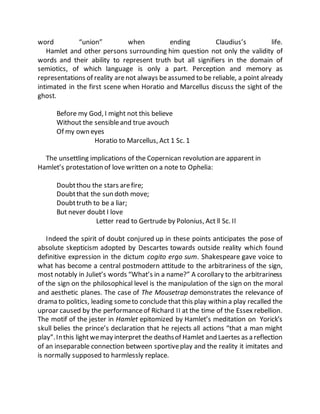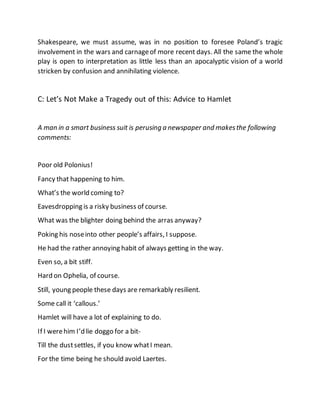The study analyzes Shakespeare's 'Hamlet' from linguistic, historical, and philosophical perspectives, focusing on the existential questions raised in the play, particularly through the verb 'to be.' It examines Hamlet's character as a complex figure reflecting conflicting ideologies and the challenges of action and emotional turmoil. The essay highlights how the interplay between being, seeming, and moral dilemmas contributes to the depth and enduring relevance of 'Hamlet' in literary discourse.





![bold indicative, which hethen juxtaposeswith “seems”.Theuseof quotation marks
in this case draws attention to words as individual bits of language rather than to
the information conveyed by words when assuming their usualsubservientrole. In
treating “seems” as a noun and thus deviating from the rules of grammar, the
author again makes us aware of the mechanics of language which we constantly
use without reflecting on them. Hamlet proceeds to expatiate on the difference
between what is and what seems – between Schein and Sein - in the lines quoted
below:
Itis not alone my inky cloak, good mother,
Not customary suits of solemn black,
Nor windy suspiration of forced breath,
No, not the fruitfulriver in the eye,
Nor the dejected ‘haviour of the visage,
Together with all forms, moods, shapes of grief,
That can denote me truly. : these indeed seem.
They are all actions that a man might play:
But I have that within which passeth show.
Hamlet in Act I sceneII evinces allthe main traits of character that later come to
the fore and manifests his basic attitudes to the world. These will undergo little
qualitative change, even after he has cause to wrestle with the possibility that
Claudius has killed his father. We find in this scene anticipations of what will more
fully emerge in great soliloquy in Act III, Sc. I. In ActI Sc. II healready contemplates
suicide while expressing countervailing fears instilled by religious teaching when
saying in the soliloquy that ends this scene:
Oh, that this too solid flesh would melt
Thaw and resolveitself into a dew !
Oh that the Everlasting had not fix’t
His canon ‘gainstself-slaughter. ..
These lines together with inferences we can draw from the great emphasis
][aced on the special prtmission required for Ophelia’s burial suggest that
Shakespeare was somewhat preoccupied with the issue of suicide at the time of
writing Hamlet. Speculations about the author apart, Hamlet questions, even](https://image.slidesharecdn.com/hamletviewedfromthreeangles3-221002152055-554013e8/85/Hamlet_viewed_from_three_angles-3-docx-6-320.jpg)









